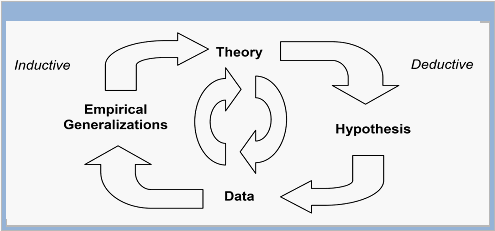

Project Team Rewards
Research Design
40
respectively and that those things that could not be measure had little or no relevance
(Trochim 2006). Today, positivism is seen by most academics as “arrogant [and]
irrelevant because its results [do] not address the real world of decision making”
(deMarrais & Lapan 2004:189).
Figure 7: The Deductive/Inductive Cycle
This thesis’
research is deductive research and follows the post-positivism approach.
Based on evidence from the literature, new ideas are created. These ideas are of general
nature and allow in a broad way to predict project members’ motivation and performance
more specifically than it was possible before. Due to time restrictions, no inductive
research could be performed to prove the ideas. Only the case study analysis gives first but
limited evidence for the validity of the thesis’ results.
The analysis of existing case studies was problematic. As found out by the literature
review, project team rewards are not well covered in literature. Therefore, it was not
surprising, that case study authors did not investigate project team rewards intensively.
52 case studies were found that initially seemed to be relevant for this thesis. Actually, six
case studies could be used for this thesis. Only one case study explicitly was created to
analyse project team rewards. Therefore, the case study analysis has only limited validity
in verifying the literature-based research results.
Figure 7: The Deductive/Inductive Cycle
Adopted from Handy (2006:1)
| Please note: All rights of this webpage are reserved. No part of this webpage may be reproduced, stored in a retrieval system, or transmitted in any form or by any means electronic, mechanic, photocopying, recording or otherwise without the prior written permission by the author. This html version of the book Project Team Rewards: Rewarding and Motivating your Project Team is not suitable for referencing since page numbers and layout may differ from the original book. Layout flaws are due to converting difficulties from the original file format to html and are not present in the paper copy of the book. |

